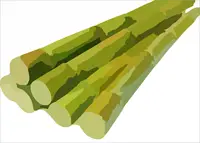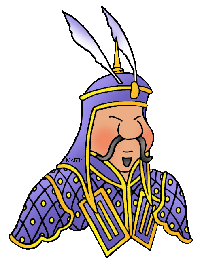Ancient Indian Food
 Do you like the flavor of cinnamon? Do you think most food tastes better with a little salt and pepper? Do you like sugary sweets and candy? Do you that know sugar, cinnamon, and pepper all come from India?
Do you like the flavor of cinnamon? Do you think most food tastes better with a little salt and pepper? Do you like sugary sweets and candy? Do you that know sugar, cinnamon, and pepper all come from India?

Early Indian Diet
The ancient Indians ate a diet of mostly wheat, barley, vegetables, fruits (Indian dates, mangoes, and berries), meats (cow, sheep and goats), and dairy products. Archeologists have found fishing nets and hooks in the ruins of early Indian civilizations, showing that they also liked to catch and eat fish.
We know that they grew rice, peas, sesame, and melons. And they domesticated cows, pigs, buffalo, and sheep. They cooked using clay ovens, cauldrons, and open fires. And they knew how to dry and pickle food to preserve it.
If you visited someone in early India, you would most likely be served rice, veggies, meat, and wheat bread. There would be a difference depending on which region you were in.
In the north, they tended to eat food that was more bland (not spicy), with a lot of dairy products (yogurt and butter), and lentils. In the south, you might find the food spicier, and served with rice and maybe coconut. Those who lived near the oceans, rivers, or lakes would serve fish and seafood.
Later on, religion began to influence what food was eaten. The Hindus came to see the cow as a sacred animal, and would not eat it. Muslims were forbidden to eat pork as well. And though India had learned about chickens from Thailand and sheep from the Middle East, many Indians chose to be vegetarians, rather than be guilty of killing animals.
Food was seen as important to a person’s holiness. There were many rules and rituals regarding food. For example, people were forbidden from eating carnivorous animals (animals that eat meat), and from eating garlic. It was believed that a person’s mind was affected by his nutrition, so this was taken very seriously

Some Indian Foods
Cinnamon
 Indian people have been using cinnamon for a long, long time. Chinese writers mentioned it in 2700 BC. Cinnamon not only tastes great, it helps to preserve food as well. When people from other areas tasted cinnamon, they wanted to have it, too, and were willing to pay a good price for it. The Greeks, Romans, and Egyptians all bought cinnamon from India.
Indian people have been using cinnamon for a long, long time. Chinese writers mentioned it in 2700 BC. Cinnamon not only tastes great, it helps to preserve food as well. When people from other areas tasted cinnamon, they wanted to have it, too, and were willing to pay a good price for it. The Greeks, Romans, and Egyptians all bought cinnamon from India.
In the Middle Ages, some countries grew rich by taxing the cinnamon that was brought from India to Europe and North Africa. When the Crusades began, cinnamon was brought back to many more people. They liked it too and wanted to get more!
The love of cinnamon and other spices is one of the main reasons that European explorers set out looking for another way to get to India, whether around Africa, or across the Atlantic, which of course led to the discovery of the New World.

 One of the earliest plants that Indians grew, sugar cane was valuable both for providing energy and for its great taste. At first it only grew in the south of India, and had to be eaten quickly, before the sweet juice dried up. But, eventually scientists figured out that they could grind the sugar cane and leave the juice out to dry in clumps. These clumps of dried sugar could be transported to other places and used in trade.
One of the earliest plants that Indians grew, sugar cane was valuable both for providing energy and for its great taste. At first it only grew in the south of India, and had to be eaten quickly, before the sweet juice dried up. But, eventually scientists figured out that they could grind the sugar cane and leave the juice out to dry in clumps. These clumps of dried sugar could be transported to other places and used in trade.
When Buddhist monks brought sugar to China, the Chinese emperor was so impressed that he sent some of his people back with them to India to learn how to grow sugar cane and make sugar.
When the Muslims conquered northern India, they brought sugar back to the Islamic world, including North Africa, and Spain. Sugar was very popular there also, and farmers began to grow it in other places.
Europeans learned of sugar, as they did of cinnamon, from the Crusades. The English word sugar comes from the Indian work sharkara, which means ground or candied sugar; and the word candy comes the Indian word khanda, meaning lump of sugar.

Black Pepper
Like cinnamon and sugar, Indian people have been using black pepper for a very long time, and farmers began growing it in around 3000 BC. By 2000 BC, India was trading it to North India and West Asia.
It eventually spread to Greece, Rome, Europe, and China, and also became popular in the Islamic empire.

Lentils
Lentils are actually the seeds of small bushes. People have been eating lentils since about 10,000 BC. It is one of the earliest known crops. Lentils were eaten in Egypt, Greece and central Asia, and were traded to India around 2500 BC. Lentils have been an important part of the Indian diet ever since. They have a lot of protein and are easy to prepare, and people use them for soups and stews.

Recipes
Would you like to try some Indian food? You can easily find some recipes online. You can make chapatti, a flat bread made from flour and water and fried in oil; lentil stew with spices; and chicken marinated in yogurt and spices. You could also make a tasty dessert with cinnamon and sugar!


